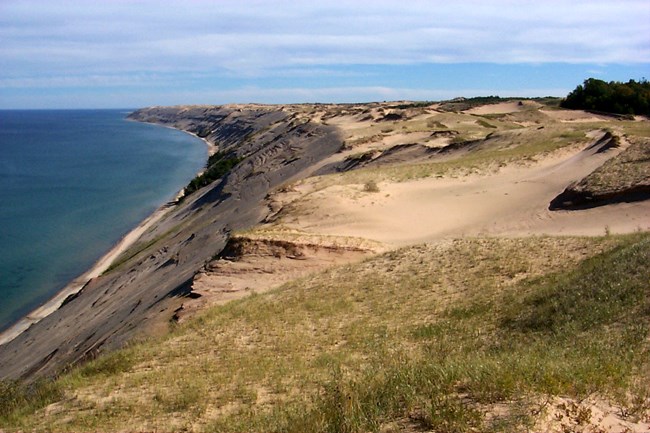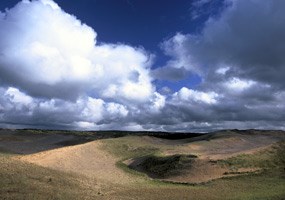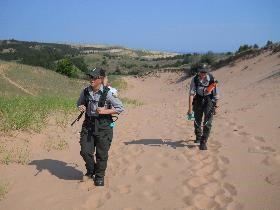
NPS photo The Grand Sable Dunes west of Grand Marais are one of the major features of the national lakeshore and among the best examples of perched dune systems in the world. Perched dunes are those that form on top of an existing coastal bluff. Michigan has two outstanding examples of these dune systems: here at Pictured Rocks and also at Sleeping Bear Dunes National Lakeshore. Transcript
Pictured Rocks National Lakeshore is well-known for its stunning multi-colored cliffs and beautiful wild beaches. But it has a third main feature that is just as stunning and just as beautiful: the Grand Sable Dunes. The dunes themselves are just the top layer of a large pile of rock rubble and debris left by ancient glaciers, called the Grand Sable Banks. Spanning five square miles, the Banks make up the eastern third of the park. And at 300 feet above Lake Superior, they are also the tallest feature in the lakeshore. Since the dunes are “perched” on top of the Grand Sable Banks, they comprise one of the best examples of a perched dune system in the world. More than just hot, dry sand, the dunes also contain dense jack pine forests and unique plants in their sheltered valleys. What makes this area so special? Let’s walk on the Dunes Trail and find out. The Dunes Trail starts at the far eastern end of the park, near the town of Grand Marais at Sable Falls. Look for the big brown trail sign near the top of the falls. After walking on the trail for a while you may wonder, as you look at the dense forest around you, “Where are the dunes?” Believe it or not, you are standing on them! But these are old, old dunes that have long been claimed and settled by many generations of plants. Newer dunes have open sands that are always changing and shifting. Look above and you’ll see the tall jack pines that dominate these older dunes. Look down and you’ll see that the trail is made of sand, not dirt. Walking on the trail is like walking forward in time, from older to younger dunes. Soon you see bare sand ahead. A quick walk up a sandy slope… and there is the first view of the top of these younger dunes, with open sand mixed with grasses, thickets, and forests beyond in sheltered valleys. If you pick up a handful of sand, you’ll see that all the grains are the same size and color. As waves erode the dune slopes facing the lake, wind blows the lighter sand up high to form the dune layer. These lighter grains are easy to blow about and sometimes they bury whole forests, as well as anything humans put in the dunes like this trail exhibit. In summer, the smell of wild roses fills the air. Sand cherries ripen in the heat. On cool evenings, small animals scurry over the sand under cover of darkness, leaving faint tracks behind.
Standing at the top of the dunes you can see deep blue Lake Superior ahead. How strange it is to have a desert-like environment so close to one of the great bodies of water on the planet. The Grand Sable Dunes are one of the most ecologically pristine of all the landscapes here in the park. Neither native Americans nor Europeans ever inhabited them. They have never been mined or logged. There are few trails that access them. These wild and open dunelands offer visitors a unique experience of solitude and silence. If you visit this dynamic, yet fragile part of the national lakeshore, please take care to walk only on trails and open sand, as many rare plants live here. Take in the sights and sounds and wildness of this special place. Don’t worry about leaving footprints behind. They will soon be erased by the wind.
Visit our keyboard shortcuts docs for details
Take a virtual hike and explore the Grand Sable Dunes at Pictured Rocks National Lakeshore. Experience the unique ecosystem of this rare landscape. 
Hiawatha Interpretive Association photo Research Natural Area Grand Sable Dunes is also a designated critical dune area by the Michigan Department of Environmental Quality. 
NPS photo Non-Native Plants |
Last updated: January 3, 2022
